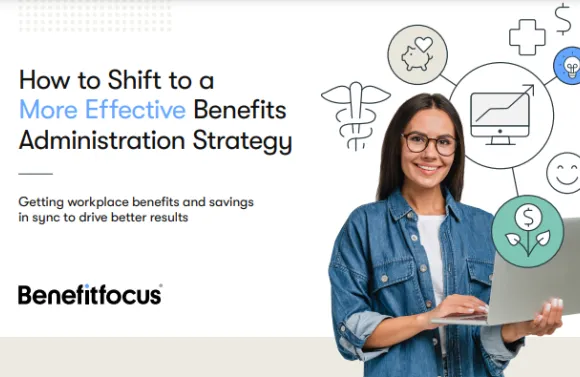
The word “benefits” springs from the Latin term benefactum, meaning “good deed.” Today, the phrase “employee benefits” often evokes mixed emotions.
On one hand, more than nine out of 10 employees connect benefits to their overall job satisfaction, according to a recent QuickBooks-Allstate Health Solutions survey. On the other hand, team members often feel confused, frustrated, and stressed when it comes to understanding and choosing from their company’s range of options.
But it doesn’t have to be this way. A proactive approach to educating and empowering team members can improve their experience with benefits programs. We’ll cover practical tips to improve how employees perceive and use your company’s offerings.
Why Team Members May Struggle with the Employee Benefits Experience
You may already know how your employees think and feel about benefits. If not, consider taking a “voice of the employee” survey to gather opinions and establish a baseline for comparison. Here are common reasons why employees may have less-than-positive perceptions of their benefits:
- Status quo bias: Enrolling in a new benefits plan or adjusting an existing one requires employees to expend mental and emotional energy. It’s often easier to keep an existing benefits selection than try something new, a phenomenon called “status quo bias.” Research shows status quo bias is a “substantial factor” in selecting health plans and retirement programs. In fact, 90 percent of employees choose the same plan they had the previous year, according to Voya research.
- Lack of time: When employees are doing more with less, they may lack time to dig into their options, pushing benefit selections to the back burner. One study found that a majority (79%) of Gen Z benefits-eligible employees spend 30 minutes or less reviewing their workplace benefits information during open enrollment, a higher share than among Millennials (68%), Gen Xers (65%), and Baby Boomers (63%).
- Crunching numbers: The math involved in benefits decisions isn’t always intuitive, and it shows in many employees’ benefits selections. Some employees end up spending more money to have a lower deductible than they would to go with a higher-deductible plan. Instead of having team members manually calculate their benefits and expenses, consider offering a benefits decision support tool that provides personalized recommendations for employees, based on their specific expected healthcare costs, where they can see the calculations.
- Navigating nuances: Health literacy is the ability to gather, process and understand information for health decisions — such as choosing a health insurance policy. If team members don’t have high health literacy, they may not know the difference between various plans or what features they should look for to meet their specific needs. They also might hesitate to ask questions because they don’t want to seem ignorant.
- Complex decision-making: If employees are wading through benefits information without any guidance, they may feel out of their depth and lack confidence in their decisions. They may pick the most expensive plan, assuming it’s the best. Or they might pick the same plan each year, even if they suspect they’re over-insured. Maybe they don’t know what questions to ask. After all, these skills aren’t taught in school.
- The benefits themselves: If your company’s benefits usage rates have room to improve, it may reflect challenges with the benefits themselves, communications about the benefits, or both. Understanding what’s at play is the first step.
Once you identify which issues affect your employees, you can address them. We’ll walk through recommendations, starting with reviewing your benefits mix.
Offering the Right Mix of Employee Benefits
According to MetLife’s Employee Benefit Trends Study, a comprehensive benefits program is a top driver of productivity, engagement and loyalty. If it’s been a while since your company adjusted its benefits offerings, it may be time to optimize them for your current workforce. Here’s how to get started:
- Ask employees: Surveys are a straightforward way to find what employees want and need. Consider sending an email survey. You can also hold focus groups with employees living through different life stages and “moments that matter,” like getting married or having a baby. Keep an ear to the ground, talk with managers and document employee feedback year-round, so you can track patterns.
- Conduct market research: The employee market is speaking — you just need to listen. Identify benefits-related trends that drive your company’s recruitment, retention and ability to be an employer of choice. Gather intelligence about industry competitors and employers in your local area. For instance, employers in your industry may be implementing more generous family leave policies.
- Show you listened: Acting on feedback helps employees feel their voice matters and the company has their best interests in mind. Allowing employee participation in benefits design can “help employees see the value in an organization’s benefit offerings,” according to a WorldatWork article.
- Offer comprehensive benefits: The definition of benefits continues to shift, with employers focusing more on different facets of well-being. About 62 percent of employers are boosting mental health services and stress/resilience management, and 27 percent are offering tools or programs to improve the physical wellbeing of employees, according to Willis Towers Watson research. Think about whether a wider range of benefits would be a fit for your team.
- Consider flexibility: Finding the right mix of benefits may be easier with flexible benefit plans that allow employees to choose the benefits they value most, researchers note in WorldatWork. Although they can be more intensive to administer, flexible benefits allow employees to gain “the positive aspect of more benefits without the same costs as providing all of them.”
Make Choosing Benefits a Positive Experience
Along with optimizing your company’s benefits, consider how you can improve the entire employee experience around benefits selection and usage. Here are a few ideas to help employees feel supported:
- Provide year-round education: Benefits typically aren’t top of mind for employees for most of the year. Consider holding quarterly “pulse checks” and share useful information about various benefit programs, and help employees feel informed heading into open enrollment.
- Communicate clearly: About 68 percent of employers say communicating benefits and well-being programs is their most important benefit priority, according to Willis Towers Watson. Simplifying and clarifying your benefits communications is a tremendous service to your employees. Make sure your top takeaways are clear and concise.
- “Shrink the change.” Focus on just one call to action in each communication to help team members overcome inertia. Strategy experts of Chip Heath and Dan Heath call this concept “shrink the change.” They write in their book Switch: How to Change Things When Change Is Hard: “Make the change small enough that they can’t help but score a victory.”
- Repeat information: If you’re sharing can’t-miss information, like a new policy option that will save employees money, tell them multiple times, using several different communication channels. Team members might need to hear from you several times before acting.
- Demonstrate impact: Your employees may not read a 20-page booklet of technical details, but a five-word headline about how much money they could save by selecting a new plan could grab their attention. Share real-life examples of how benefits can impact employees, using concrete messaging.
- Provide incentives: Every now and then, people need external motivation to push benefits selection to the top of their to-do lists. You might encourage employees to act by offering cash bonuses or gift cards, entering employees into a drawing for a larger prize like a tablet, or providing a health insurance discount or fitness watch for employees who complete a wellness program.
- Engage champions: Word-of-mouth is a powerful marketing tool. Identify employees who use and appreciate a benefits program and enlist them to share about it with their peers. Bonus: You’ll have a better understanding of why they find the program useful, so you can use that messaging in your communications.
- Offer answers up front: Give employees the quick answer first, so they can make an informed decision.
- Provide decision-making support: Some employees need a quick answer or comparison, while others want backup calculations and details.
Ready to strengthen and streamline your company’s benefits experience? Learn how to reduce your workload with Benefitfocus!
The information provided does not, and is not intended to, constitute legal advice; instead, all information and content herein is provided for general informational purposes only and may not constitute the most up-to-date legal or other information.
CN 4302360_0327


